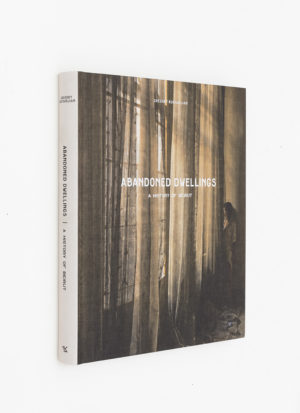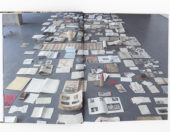
Abandoned Dwellings: A History of Beirut
Overview
Over the past 150 years, Beirut has witnessed a cycle of unbridled growth, war, economic and social crises and migratory movements. It is in this territory ceaselessly destroyed and rebuilt, broken and regenerated, that Gregory Buchakjian has undertaken an artistic project and a research devoted to abandoned dwellings. Disclosing the survey of 744 buildings, the collection of archives and testimonies, a PhD thesis and the creation of photographic tableaux with the subjects surrounded by sagging furniture and mounds of rubbish, the process that constitutes the present book proposes new perspectives towards the city as well as instruments to reclaim it at times it is confronted with various forms of violence.
About the Artist
Gregory Buchakjian
Gregory Buchakjian is an art historian and interdisciplinary visual artist. He lives and works in Beirut where he was born in 1971. PhD graduate at Sorbonne Université, he is director of the School of Visual Arts and Associate Professor at Académie Libanaise des Beaux-Arts (ALBA). Buchakjian’s practice is based on narrative, archive and archeology. Investigating on urban turmoil, dereliction and heritage engendered his PhD dissertation, the subsequent book, Abandoned Dwellings, A History of Beirut (Beirut, Kaph Books: 2018, Valerie Cachard, ed.) and the solo exhibitions Abandoned Dwellings, Display of Systems (Beirut, Sursock Museum, 2018 curated by Karina El Helou) and Abandoned Dwellings of Beirut (Brussels, Villa Empain, 2019). In 2018, he was showcased in the first national pavilion of Lebanon at the Venice Architecture Biennale and he contributed to the Works on Paper accompanying Karina El Helou's Cycles of Collapsing Progress exhibition in Oscar Nimeyer's Tripoli International Fair. In 2019 he conceived the installation Where do filmmakers go? for the 2nd Alba Cinema encounters, "Filming in Times of War", which he co-organized. In 2021, he created with Valérie Cachard and Sary Moussa the video Agenda 1979 at the invitation of the Opera National du Rhin, and the installation Hercules and Omphale for the exhibition How will it end? (Villa Empain, Brussels, in partnership with Centre Pompidou), based on a painting that was damaged by the blast of the 4th of August 2020 he attributed to Artemisia Gentileschi. In 2022, he premiered at Fotofocus Biennial Cincinnati his long-term Record of an Ordinary Life and intervened with Temporary art Platform in the Roman Temple of Hosn Niha. Member of the advisory committee of the Saradar Collection, he took part in many juries including Sursock Museum Salon d’Automne (2009), Boghossian Prize (2012), Beirut Art Center’s Exposure (2013), Beirut Art Residency (2017) and Arab Documentary Photography Program (2019).
About the Authors
Gregory Buchakjian
Gregory Buchakjian is an art historian and interdisciplinary visual artist. He lives and works in Beirut where he was born in 1971. PhD graduate at Sorbonne Université, he is director of the School of Visual Arts and Associate Professor at Académie Libanaise des Beaux-Arts (ALBA). Buchakjian’s practice is based on narrative, archive and archeology. Investigating on urban turmoil, dereliction and heritage engendered his PhD dissertation, the subsequent book, Abandoned Dwellings, A History of Beirut (Beirut, Kaph Books: 2018, Valerie Cachard, ed.) and the solo exhibitions Abandoned Dwellings, Display of Systems (Beirut, Sursock Museum, 2018 curated by Karina El Helou) and Abandoned Dwellings of Beirut (Brussels, Villa Empain, 2019). In 2018, he was showcased in the first national pavilion of Lebanon at the Venice Architecture Biennale and he contributed to the Works on Paper accompanying Karina El Helou's Cycles of Collapsing Progress exhibition in Oscar Nimeyer's Tripoli International Fair. In 2019 he conceived the installation Where do filmmakers go? for the 2nd Alba Cinema encounters, "Filming in Times of War", which he co-organized. In 2021, he created with Valérie Cachard and Sary Moussa the video Agenda 1979 at the invitation of the Opera National du Rhin, and the installation Hercules and Omphale for the exhibition How will it end? (Villa Empain, Brussels, in partnership with Centre Pompidou), based on a painting that was damaged by the blast of the 4th of August 2020 he attributed to Artemisia Gentileschi. In 2022, he premiered at Fotofocus Biennial Cincinnati his long-term Record of an Ordinary Life and intervened with Temporary art Platform in the Roman Temple of Hosn Niha. Member of the advisory committee of the Saradar Collection, he took part in many juries including Sursock Museum Salon d’Automne (2009), Boghossian Prize (2012), Beirut Art Center’s Exposure (2013), Beirut Art Residency (2017) and Arab Documentary Photography Program (2019).
Valérie Cachard
Née à Beyrouth en 1979, Valérie Cachard est de formation littéraire et journalistique. Chargée de cours à l’USJ et à l’ALB,A elle anime des ateliers d’écriture et de théâtre. Lauréate du Prix du Jeune Écrivain Francophone et du prix Etel Adnan Award for women playrights, elle bénéficie d’une résidence d’écriture au Théâtre du Tarmac en 2010. Elle est l'auteure de récits - Déviations et autres détours - (Tamyras, 2016) et de pièces de théâtre - Matriochka – (Antoine, 2015) ainsi que d'écrits accompagnant des travaux artistiques - Nos âmes en chantier avec Saïd Baalbaki et "Géographie du printemps" avec François Sargologo. Elle a édité “Habitats Abandonnés. Une histoire de Beyrouth”, de Gregory Buchakjian avec qui elle a également produit une performance filmée intitulée Archives.
Technical Details
- Publication Date:
- Thursday, November 29, 2018
- Language:
- English or French
- Format:
- Hardcover, Fabric Cover
- Dimensions:
- 24x29cm
- Weight:
- 1340g
- ISBN:
- 9786148035111
- Number of Pages:
- 240
- Publisher:
- Kaph Books
- Categories:
- The Arts

